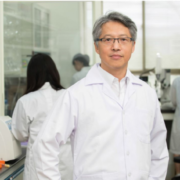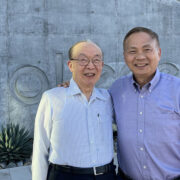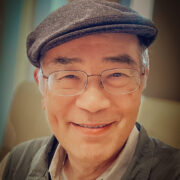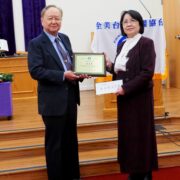Nylon Panty Hose Journey 尼龍絲襪之旅
By Sue Shwu Lih Lin (林淑麗)
I.
When I grew up in the Linyun village (林園 ) of Taiwan during the 1950s, nylon stocking was a luxurious accessory my mother wore for special occasions. To wear it, she carefully gathered along the length of the legging so that her toes can reach the end with ease, pulled it up very slowly, stretching it all the way to the upper leg, and secured it with the hook of a girdle. I was so impressed by the glittering and slender new look of her legs. But what is nylon?
My enlightenment came many years later, when I took the polymer chemistry course in the early 1970s as a chemical engineering major in National Taiwan University (NTU). I learned that the raw materials for nylon are of the same origin as the brush for bathtubs. They all come from the refining of petroleum. And what is petroleum? It is essentially a derivative of life: Dead plants and tiny marine organism buried hundreds of thousands, even million years ago, disintegrated overtime under high temperature and pressure; forming a thick yellowish black mixture of hydrocarbon compounds we called petroleum. After a series of petroleum engineering process applied to the oil reservoir, the liquid is processed through a series of distillers and extractors, resulting in a few basic petrochemicals, which are building blocks for accessories of modern life raging from the carpet we step on to the contact lens we wear.
The discipline of chemical engineer is to master all the gadgets for this magic transformation. It should be no surprise if people picture a typical female chemical engineering student as someone wearing goggles in the laboratory and glasses in the classroom, staring straight to the blackboard without passing a side glance at the boys seated next to her. Real life proved to be more counterintuitive: The tiny crop of female students in my class featured a variety of talents, capable of dazzling the crowd on a dance floor, bringing laughter during study break, even holding the boys spellbound by the way they move. In comparison, I was rather shy, a product of the reserved, austere southern upbringing. I carried my small frame through the steel and concrete engineering building day in and day out, climbing the wide steps in the spacious hallway to second floor, rubbing elbows with the rough-edged male engineering students. If I were intimidated at heart, I covered it up with my freewheeling ease. In a letter to my parents during this time, I wrote,” I have lived my life as I pleased: talked loud, skipped the class, studied hard and recuperated from stress by eating. “
The curriculum of chemical engineering encompasses broad discipline and can sound quite overwhelming: “Materials and Energy Balance,” “Transport Phenomena,” ”Thermodynamics,” “Kinetics,” ”Process Design,” “Process Control,” you name it. It is the training ground for a master of modern manufacturing process, someone who can speak the language of chemist, materials scientist, as well as electronic engineer, mechanical engineer, or even civil engineer.
What motivated someone like me, whose favorite pastime was to curl up in a Japanese style quilt cabinet and read stories, to pursue a career in designing distillation tower, monitoring the startup and shutdown of a chemical reactor? What should have come to the mind of a bookworm to seek such transformation? In retrospect, I had to admit that I had spent my days in college as if there were no tomorrow. My drive took nourishment from bitter awareness of gender inequality and a strong desire to prove one’s self-worth in a male-dominated field.
In the 1960s, I was not aware of the publication of Betty Friedan’s “The Feminist Mystique.” Neither was I a follower of Simone Beauvoir. My rebellion is not “a revolutionary uproar from the depth of the soul” (Quoted from Mao Zedong) It had no clear sense of mission, no well mapped out strategies for success. The gratification came from experiencing the rigor of the discipline, and knowing that I endured.
Came graduation time. Bidding farewell to the palm-tree-lined boulevard would have been a sad song without the ceremonial presence of parents, school officers, all formally dressed and seated, while the parade of young graduates in black gowns and caps from the six colleges of the University converging outside the Stadium. Now, with a mixed feeling of nostalgia, repentance and sorrow, I turned the pages of the faded photos of this day to adore the monument of my youth: group photos with classmates and dormitory roommates, intimate portraits with goofing-off buddies; we sat on the lawn, posed in front of the Fu’s Bell
(傅鐘)… In one of those photos, I was passing by a shaded tree, flanked by my mother and my brother, who was in the sixth-year class at the Medical College of NTU. I wore a tightly-fitting pink cheongsam (旗袍). The slightly waved hair fell softly over the shoulder. A pair of high-heeled shoes and, yes, nylon pantyhose, completed the ensemble. My feelings at the time were not that of assurance, but of panic and regret—I wondered whether my youth had faded without bearing any fruit.
II
Can you imagine a glass fiber with the diameter of one hundredth of a hair, and yet carrying over a thousand times as much message of that of coaxial cable? How a chemical engineer graduate, who missed the train of nylon fiber revolution ended up tangled in the optical fiber revolution? Do the questions sound irreverent? Not so from today’s perspective: Living in the digital age, we are conditioned to make the leap of faith, to see the smile, motion of our loved ones from far away reaching us through electronic gears. Less well-known though, is the science behind it: your audible speech, moving image are treated as data, chopped into a maze of zero and one, channeled through, for example, optical glass fiber and restored to the original at the receiving end, even it had to cross the ocean through undersea cable! But in the 1970s, it may sound like science fiction. Equally, I was unprepared for a leap of faith in life events.
Now let us change the topic, and consider the basic unit of the universe: atoms. In precollege chemistry, we learned about the atomic structure: the nucleus, the electron orbitals, and the quantum energy levels associated with the orbitals. Electrons, statistically, distributes among orbitals of discrete, or digitized, energy levels. Upon proper stimulation, electrons can ascend or descend to orbitals of other discreet energy levels, as a result, absorbing or releasing energy corresponding to certain discrete frequency in spectra. This is a close analogy of digitization.
Life sometimes imitates science. A trigger out of nowhere could bring about a quantum-like transition to an unfathomable state of existence. Here is my story: It is in the mid- spring of 1974. Kaohsiung, a seaport in southern Taiwan, was bathed in warm tropical sunlight. After a half-day’s work on Saturday, a coworker of mine at the Metallurgical Research Institute invited me for a movie. We bought the tickets and sat down in an ice cream parlor, waiting for the show. I went to the public phone to give my mother a call. Hearing my voice, she exclaimed before I had a chance to talk, “Shwu-lih, you had an offer for admission and a teaching assistantship from Miami University.” I was stunned and speechless.
Let me explain: There was a jargon in the 1960s and 1970s: Come, come, and come to Taida (Mandarin pronunciation of National Taiwan University); go, go, and go to USA. During the junior year, many of my classmates set their priority just as if dictated by it. My family had been rooted in Southern Taiwan for over ten generations; going abroad was not part of my plan. Those whose family migrated to Taiwan during the 1940s’ retreat of Chiang-Kai-Shek’s government from China were more inclined to make the move. Influenced by the peer culture, and perhaps subconsciously positioning myself for options, I also took the requirement tests: TOFEL (Test of English as a Foreign Language) and GRE (Graduate Record Examination.) The scores turned out to be quite good.
Fresh out of college, I worked in NTU’s department of Chemical Engineering as teaching assistant and had some leisure to explore the temptation of cosmopolitan Taipei. At the year’s end, my life was in a state of flux. This time, an old idiom called to me: Back to where you belong; come back before the plantation went arid. So I moved south, lived with my parents, and worked in the Metallurgical Institute. But the laid-back atmosphere in Southern Taiwan was not a good fit either. Besides, there was the constant pressure of arranged dating. To break the dull, I took a trip to Taipei and stayed with my sister, who now lived in my family’s apartment just as I did a year ago. There was stuff I left behind in a desk. During a cleanup, I discovered a graduate school application form from Miami University, Oxford, Ohio. My classmate L obtained the form but did not end up using it. Instantly, I told myself: why not take a chance? I already met the test requirement. All I need were letters of recommendation. Two college professors and my supervisor at Metallurgical Institute kindly provided the letters. The whole process was like a jogging after work. It helped circulation and released tension. Afterwards, it was forgotten.
The opportunity offered by Miami University was a prelude to a sequence of events not unlike quantum transitions from my personal perspective. One day in September, 1974, an airplane took me across the Pacific Ocean, arriving around midnight at San Francisco. I gazed through the airplane window and saw a sea of light. I should add, it was unlike a virtual city wired together by the magic of laser light. The breakthrough research was underway at the time—compound semiconductor laser and optical fiber communication. One day, the laser light, traveling in a modulated Giga-Hertz frequency through optical glass fiber, buried under the ocean, will carry the digitized text message, audio/video content across the globe. As a matter of fact, Google, founded in 1998 and becoming a household name, has become one of the big investors in laying undersea glass cables for internet traffic. And in 1990, I was in San Francisco for the second time, to attend a symposium, held at the Marriot Hotel near China Town, on optical fiber communication technology. My company Lytel, which later became part of Tyco Electronics, sent me here.
This company, situated at Somerville, New Jersey, was founded in1983 by one legendary laser physicist, Gene, of Bell Laboratories. He and his team, including Ron, held the ambition of making it the “Intel Corporation” of the III-V compound semiconductor devices. At the time I joined the company, two types of light source, laser and LED, and a PIN detector were under prototype development. Additionally, the company was designing a transceiver module. In this type of start-ups, physicists were usually the driving force of the new invention. They conceived the microstructure of chips, which eventually become the light source or detector in the transceiver, the key system in the emerging optical fiber communication. People trained in materials science, chemistry, or chemical engineering were usually responsible for crystal growth and wafer processing. The packaging engineer took the chip and transformed it into a module. Last but not least, the electronic engineer designed the transceiver circuits, where these light source/detector modules were housed. They enjoyed more visibility due to frequent interaction with the marketing department.
After writing a thesis in the subject of Infrared spectroscopy in Miami University, and being polished further in the graduate school of Rutgers University with a master’s degree in chemical engineering, would I not be somehow at a loss in Lytel? Perhaps I could talk about how we relocated to the high-tech incubator, New Jersey, or elaborate on the W-shaped recession encountered upon graduating from Rutgers in 1982. Rather, let me take you for another quantum jump.
During my study and working career, if there were someone I would call a mentor, it would have been Randy, the materials development manager who hired me. A typical Lytel engineer or scientist usually appeared a bit nerdy, but was fun to be with. Randy was not the least of them. However, I was most impressed by his openness in sharing knowledge. A Ph.D. in chemistry from M.I.T, he masterminded the automation of Lytel’s high temperature crystal growth furnace, which became a showcase for his expertise in electronics, computer software, instrumentations, and materials science. It was very instructive to learn how he constructed the InGaAsP quaternary compound phase diagram from scratch, employing thermodynamic constants, such as enthalpy and entropy, extracted from various scientific publications.
However, a problem in controlling the composition of crystal layers continued to puzzle him during the early phase of development. It was related to the incorporation of impurity in semiconductor crystal lattice, called doping. Doping is an important feature in device design. It alters the conductivity of the semiconductor layer. There are two types of impurity, one called a donor, the other an acceptor. The specific problem Randy encountered was related to the activation efficiency of the zinc impurity, an acceptor, in the crystal lattice. If the impurity failed to incorporate into the proper position in crystal lattice, it was considered inactive. Low activation efficiency is indicated when the carrier (zinc acceptor) concentration, as measured by Polaron profiler, did not follow what is predicted by the distribution coefficient between melt and the thin film crystal. The scientific community had attempted to offer explanations, but to little avail. After recent reorganization, Randy was to oversee the development of three devices, namely, laser, LED and PIN. With hands full, he asked me to look into this problem.
Personal computer was a relatively new tool in the workplace during the 1980s. It turned out to be quite useful for my investigation. With the help of statistical software, I looked into a few scenarios that could possibly explain the inactivation. In the April of 1987, four months after joining Lytel, I issued an engineering note summarizing the preliminary analysis. A breakthrough came soon after: I envisioned the scenario of zinc diffusion in the crystal lattice during the growth of epitaxial layers and came up with a postulation: it takes time for zinc to diffuse into the crystal lattice once the thin film formed; thus the degree of activation may correlate with the length of time used to grow the subsequent layers. The preliminary linear regression of all accumulated data showed the relevancy of the hypothesis. After removing the one far-off data point, the statistical regression resulted in a R-squared value of over 80%, indicating strong correlation. This finding took Randy by surprise. After all, my discipline in chemical engineering offered some complimentary advantage in this environment. The finding paved the foundation for the U.S. patent #5,264,397, titled “Method for Activating Zinc in the Active Layer of Semiconductor Device.” When it got approved in 1993, I already left. Reality set in sooner: The market for the fiber optic technology had yet to take off. It was time to move on.
III
Great Gorge is a ski resort near the northern border of New Jersey. I spent a few days there in 1991, not on the snow-covered slope, but inside a cozy conference room of a hotel, attending a workshop on “how to enhance creativity.” The instructor, I vividly recall, was short but possessed a commanding presence. Though I lost the class handouts during relocation, one slide he showed toward the conclusion of the class still sticks in my head to this day: an eagle hovering over a cliff. Raising his voice, he asked, “If you were caught between a cliff and a beast, what did you do except to take off like an eagle?”
A person in the right mind would have shrugged off such a notion, taking it as snake oil peddled by a desperate enchanter. However, what I saw was a group of technologists hard at work, bending their heads and scribbled on the note pads. These were well-groomed engineers from the corporate headquarter of Nabisco Brands, a unit of RJR Nabisco.
The company prided itself with award-winning office architecture, situated near the downtown of East Hanover, New Jersey. The buildings rest on a vast carpet of green grass. Giant pine trees cast shade in the narrow winding paths, which were numerous on the curved slope of the landscape. During lunch break, workers hanged about outside the office building, some jogging. If my colleagues in Lytel exemplified the nerdy type of corporate America, those in Nabisco stood to be the sensible ones, nourished by a corporate life style made possible partly by the affluent consumers of North America.
How a biscuit maker managed to rise from the ordinariness of kitchen craft to such impressive statue, and to be able to afford such luxury, was anybody’s guess. However, it might not have been what stirred the appetite of a few venture capitalists in the 1980s. The fight for control ended when the notoriously audacious KKR group took it private in a twenty three billion dollars leveraged buyout. A book, “Barbarian at the Gate: The Fall of RJR Nabisco,” detailed the drama of corporate maneuver, betrayal and greed, centering on the role of then president, Ross Johnson. The story also captivated national audience in a mini cable TV series of the same name. Even the prestigious Kellogg School of Management of Northwestern University incorporated the episode in the curriculums to demonstrate the vice (or virtue?) of leveraged buyout.
The head of the Process Development Division was no less intriguing. Her office was not far away from my cubicle. But she usually was on the phone when I passed by. Pieces of her conversation occasionally reached my ears. As a result of the day-to-day exposure, I began to see her as being rather temperamental, shrewd, ambitious, and even manipulative. To be fair, she had treated me quite politely, even praised my report during one of the monthly department meeting. I have a souvenir from the days of our encounter: The certificate awarded to me for completing the workshop on “Enhancing Creativity in Engineering Design and Problem Solving,” which she signed as senior director of Manufacturing and Process Development.
The group I worked for had a few joint projects with the “Fundamental Science department,” which was in the other side of the building. I used the HPLC (High Performance Liquid Chromatography) instrument in one of the laboratories for the analysis of protein fraction, such as gluten, in the dough. The data will be useful in optimizing the dough mixing and proofing parameters. My experience working here would be quite dull without the aromatic smell of laboratory cookies, a welcoming feature for visitors. The laboratories engage in variety of research projects ranging from the biochemical properties of biscuit ingredients to the rheology of the dough. Here, flour is a significant subject of research. Flour experts have to keep a close watch on the seasonal availability of crops from different part of the country. Weather and soils play important roles in the quality of flour, which in turn affects many aspects of cookie manufacturing. They mix and match the flour variety from inventories in order to achieve consistency and economy.
The first step in the manufacturing of cookie is mixing and proofing of dough. This is where my project targeted. Flour, water and enzyme are three basic components in the raw materials. Other ingredients include baking soda, yeast and margarine. During mixing and proofing, large protein molecules undergo hydrolysis, resulting in smaller protein molecules called glutens. A close analogy would be to tear down the nylon fabric of a panty hose, scramble it into loose balls. The gluten content in dough affects how well the cookies stay in shape during baking as well as the dimension and unit weight of baked cookies. Factors affecting the gluten content include mixing time, proofing time, enzyme and water concentration, etc. Scientists usually performed a factorial design of experiments for process optimization. Data gathering usually takes months and even years, with pilot runs conducted in the manufacturing facilities away from the corporate headquarters. So much was my mission at Nabisco.
“You came from fiber optics industry to biscuits manufacturing? It is a world apart.” A British consultant exclaimed in disbelief. He lived in England and usually flew across the Atlantic Ocean in order to work here for a few days. He often went straight into an all morning conference with a team of dough machine engineers. We chatted occasionally when he took break in the cubicle at the opposite side of mine. His question was quite typical and, as usual, I took it in stride. “There is more similarity than difference between what I used to do and what I do now. The underlying principles are all the same….” I would reply.
A more challenging question for me was “When you are caught between a cliff and a beast, what do you do except to take off and fly like an eagle?”
I read a fascinating story during the early 1960s while growing up in Taiwan. The illustrated story, possibly an adaptation of Trojan War in the Greek epic, Iliad, depicted a palace on fire during the siege. A baby phoenix was trapped in a golden cage. The spirit of the mother bird descended in time to rescue the baby, imparting strength and enabling it to break free. The phoenix, according to an Egyptian legend, lives in the desert for five hundred years in a life span; it then burns itself to ashes, from which rises a new bird. I was very impressed.
Gone were the good old days. I was into my 40s. The United States just exited the Gulf war in triumph. The Dow Jones Industrials index started to exhibit some momentum after moving sideways for a few years. A dark horse from Arkansas moved into the White House. But these national headlines did not mean much to me. I was consumed by years of long commute, in a bumper to bumper traffic on Garden State Highway for two to three hours a day. At night, I lay down to watch TV, only to fall to sleep. I could not find enough energy and time for my daughter, who was about eight. My husband had done most of the chauffeuring for her activities. We rarely talked to each other, as the conversation usually turned to arguments. I felt alienated working along with those food technologists. Every sign suggested that the girl who set out to prove herself to the world might be near the end of the road: Going nowhere, seeing no way out. Am I going to take off like an eagle? Or burned myself to ashes like a phoenix?
Source from Sue Shwu Lih Lin (林淑麗)
Posted on 12/13/2018





